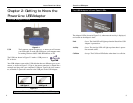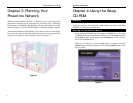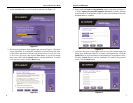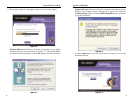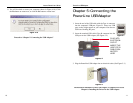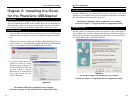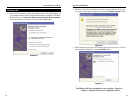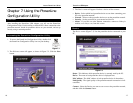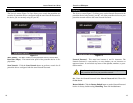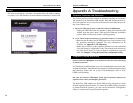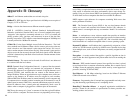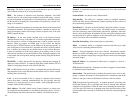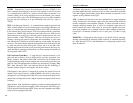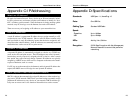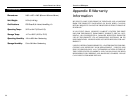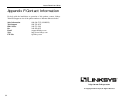
PowerLine USB Adapter
Network - A system that transmits any combination of voice, video and/or data
between users.
Network Mask - also known as the “Subnet Mask.”
Plug-and-Play - The ability of a computer system to configure expansion
boards and other devices automatically without requiring the user to turn off
the system during installation.
PowerPacket™ - The basis for the HomePlug™ Powerline Alliance 1.0 speci-
fication, PowerPacket is a robust, secure, and reliable means of transferring
data. This technology reduces interference generated by appliances, electronic
devices, and halogen lights. PowerPacket also has encryption techniques built
into the hardware to prevent neighbors on the same power grids from gaining
access to sensitive data or the Internet connection.
Powerline Networking - Data transmission over powerlines.
RJ-45 - A connector similar to a telephone connector that holds up to eight
wires, used for connecting Ethernet devices.
Router - Protocol-dependent device that connects subnetworks together.
Routers are useful in breaking down a very large network into smaller subnet-
works; they introduce longer delays and typically have much lower throughput
rates than bridges.
Static IP Address - A permanent IP address that is assigned to a node in a
TCP/IP network.
STP (Shielded Twisted Pair) - Telephone wire that is wrapped in a metal sheath
to eliminate external interference.
Subnet Mask - The method used for splitting IP networks into a series of sub-
groups, or subnets. The mask is a binary pattern that is matched up with the IP
address to turn part of the host ID address field into a field for subnets.
TCP (Transmission Control Protocol) - A method (protocol) used along with
the Internet Protocol (IP) to send data in the form of message units between
computers over the Internet. While IP takes care of handling the actual deliv-
ery of the data, TCP takes care of keeping track of the individual units of data
(called packets) that a message is divided into for efficient routing through the
Internet.
25
Instant PowerLine
TM
Series
Hot Swap - The ability to replace a card or other hardware part in a hardware
device without turning it off or losing functionality.
IEEE - The Institute of Electrical and Electronics Engineers. The IEEE
describes itself as “the world’s largest technical professional society—promot-
ing the development and application of electrotechnology and allied sciences
for the benefit of humanity, the advancement of the profession, and the well-
being of our members.”
The IEEE fosters the development of standards that often become national and
international standards. The organization publishes a number of journals, has
many local chapters, and has several large societies in special areas, such as the
IEEE Computer Society.
IP Address - In the most widely installed level of the Internet Protocol
(Internet Protocol) today, an IP address is a 32-binary digit number that identi-
fies each sender or receiver of information that is sent in packets across the
Internet. When you request an HTML page or send e-mail, the Internet
Protocol part of TCP/IP includes your IP address in the message (actually, in
each of the packets if more than one is required) and sends it to the IP address
that is obtained by looking up the domain name in the Uniform Resource
Locator you requested or in the e-mail address you're sending a note to. At the
other end, the recipient can see the IP address of the Web page requester or the
e-mail sender and can respond by sending another message using the IP address
it received.
IPCONFIG - A utility that provides for querying, defining and managing IP
addresses within a network. A commonly used utility, under Windows NT and
2000, for configuring networks with static IP addresses.
ISP - An ISP (Internet service provider) is a company that provides individuals
and companies access to the Internet and other related services such as website
building and virtual hosting.
LAN - A local area network (LAN) is a group of computers and associated
devices that share a common communications line and typically share the
resources of a single processor or server within a small geographic area (for
example, within an office building).
MAC Address - The MAC (Media Access Control) address is a unique num-
ber assigned by the manufacturer to any Ethernet networking device, such as a
network adapter, that allows the network to identify it at the hardware level.
24



